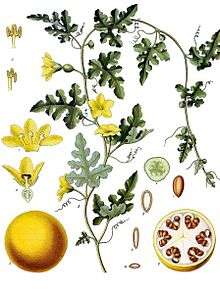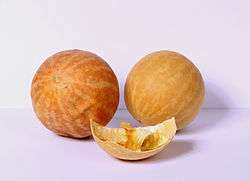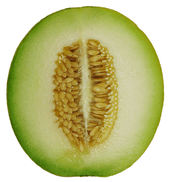Citrullus colocynthis
Citrullus colocynthis, with many common names including colocynth,[2] bitter apple,[2] bitter cucumber,[2] desert gourd, egusi,[3] vine of Sodom,[2] or wild gourd,[2] is a desert viny plant native to the Mediterranean Basin and Asia, especially Turkey (especially in regions such as İzmir), and Nubia.
| Citrullus colocynthis | |
|---|---|
 | |
| Citrullus colocynthis from Koehler's Medicinal-Plants (1887). | |
| Scientific classification | |
| Kingdom: | Plantae |
| Clade: | Tracheophytes |
| Clade: | Angiosperms |
| Clade: | Eudicots |
| Clade: | Rosids |
| Order: | Cucurbitales |
| Family: | Cucurbitaceae |
| Genus: | Citrullus |
| Species: | C. colocynthis |
| Binomial name | |
| Citrullus colocynthis (L.) Schrad. | |
| Synonyms[1] | |
| |
It resembles a common watermelon vine, but bears small, hard fruits with a bitter pulp. It originally bore the scientific name Colocynthis citrullus.
Origin, distribution, and ecology
C. colocynthis is a desert viny plant that grows in sandy, arid soils. It is native to the Mediterranean Basin and Asia, and is distributed among the west coast of northern Africa, eastward through the Sahara, Egypt until India, and reaches also the north coast of the Mediterranean and the Caspian Seas. It grows also in southern European countries as in Spain and on the islands of the Grecian archipelago. On the island of Cyprus, it is cultivated on a small scale; it has been an income source since the 14th century and is still exported today. It is an annual or a perennial plant (in wild) in Indian arid zones and has a great survival rate under extreme xeric conditions.[4] In fact, it can tolerate annual precipitation of 250 to 1500 mm and an annual temperature of 14.8 to 27.8 °C. It grows from sea level up to 1500 meters above sea level on sandy loam, subdesert soils, and sandy sea coasts with a pH range between 5.0 and 7.8.[5]
Characteristics and morphology
Roots and stems
The roots are large, fleshy, and perennial, leading to a high survival rate due to the long tap root. The vine-like stems spread in all directions for a few meters looking for something over which to climb. If present, shrubs and herbs are preferred and climbed by means of auxiliary branching tendrils.[4]
Leaves
Very similar to watermelon, the leaves are palmate and angular with three to seven divided lobes.
Flowers
The flowers are yellow and solitary in the axes of leaves and are borne by yellow-greenish peduncles. Each has a subcampanulated five-lobed corolla and a five-parted calyx. They are monoecious, so the male (stamens) and the female reproductive parts (pistils and ovary) are borne in different flowers on the same plant. The male flowers’ calyx is shorter than the corolla. They have five stamens, four of which are coupled and one is single with monadelphous anther. The female flowers have three staminoids and a three-carpel ovary. The two sexes are distinguishable by observing the globular and hairy inferior ovary of the female flowers.[4]

Fruits
The fruit is smooth, spheric with a 5– to 10-cm-diameter and extremely bitter taste. The calyx englobe the yellow-green fruit which becomes marble (yellow stripes) at maturity. The mesocarp is filled with a soft, dry, and spongy white pulp, in which the seeds are embedded. Each of the three carpels bears six seeds. Each plant produces 15 to 30 fruits.[5]
Seeds
The seeds are grey and 5 mm long by 3 mm wide. They are edible but similarly bitter, nutty-flavored, and rich in fat and protein. They are eaten whole or used as an oilseed. The oil content of the seeds is 17–19% (w/w), consisting of 67–73% linoleic acid, 10–16% oleic acid, 5–8% stearic acid, and 9–12% palmitic acid. The oil yield is about 400 l/hectare.[6] In addition, the seeds contain a high amount of arginine, tryptophan, and the sulfur-containing amino acids.
Cultivation
C. colocynthis, a perennial plant, can propagate both by generative and vegetative means. However, seed germination is poor due to the extreme xeric conditions, so vegetative propagation is more common and successful in nature. In the Indian arid zone, growth takes place between January and October, but the most favorable period for the vegetative growth is during summer, which coincides with the rainy season. Growth declines as soon as the rains and the temperature decrease and almost stops during the cold and dry months of December and January. Colocynth prefers sandy soils and is a good example of good water management which may be useful also on research to better understand how desert plants react to water stress.[7][8] To enhance production, an organic fertilizer can be applied.[9] Colocynth is also commonly cultivated together with cassava (intercropping) in Nigeria.

Cultivated colocynth suffers of climatic stress and diseases such as cucumber mosaic virus, melon mosaic virus, Fusarium wilt, etc. as any other crop. To improve it, a relatively new protocol for regeneration has been developed with the aim of incorporating disease and stress resistance to increase yield potential and security avoiding interspecific hybridization barriers.[10]
Uses
C. colocynthis can be eaten or elaborated for further uses in medicine and as energy source, e.g. oilseed and biofuel. The characteristic small seed of the colocynth have been found in several early archeological sites in northern Africa and the Near East, specifically at Neolithic Armant, Nagada in Egypt; at sites dating from 3800 BC to Roman times in Libya; and the pre-pottery Neolithic levels of the Nahal Hemar caves in Israel.[11] Zohary and Hopf speculate, "these finds indicate that the wild colocynth was very probably used by humans prior to its domestication."[11]
Traditional medicine
Colocynth has been widely used in traditional medicine[12] for centuries.[13] In premodern European medicine, it was an ingredient in the electuary called confectio hamech, or diacatholicon, and other laxative pills.[14]
In Arabia the colocynth had numerous uses in traditional medicine, such as a laxative, diuretic, or for insect bites.[15] The powder of colocynth was sometimes used externally with aloes, unguents, or bandages.[14] Troches made of colocynth were called "troches of alhandal" used as an emetic.[14]
In traditional Arab veterinary medicine, colocynth sap was used to treat skin eruptions in camels[15].
Culinary uses
The seeds of colocynth, which must be heated to make edible, have been used since antiquity as a food source in areas of the Sahara and Sahel where crops frequently fail or regular farming is impossible. The enigmatic early Egyptian ceramic Clayton rings found in the Western Desert may have been portable ovens for roasting colocynth seeds.[16] The desert Bedouin are said to make a type of bread from the ground seeds. The closely related watermelon (Citrullus lanatus (Thunb)) was domesticated in Ancient Egypt, and may have been developed for edible seed from cultivated colocynth.[17] In West Africa, some confusion exists between this species and watermelon, whose seeds may be used in much the same way. In particular, the name "egusi" may refer to either or both plants (or more generically to other cucurbits) in their capacity as seed crops, or to a popular soup made from these seeds. The seed flour is rich in micronutrients[18], and could therefore be used in food formulations especially in regions with endemic micronutrient deficiencies, such as West Africa.[19]
Other uses and research
The oil obtained from the seeds (47%) can be used for soap production.[5] The production is not very time- and energy-consuming due to the ability of colocynth to grow on poor soils with just a little moisture and organic fertilizer. The fruits are harvested still unripe by hand, the rind is removed by peeling and the inner pulp filled with seeds is dried in the sun or in ovens. The seeds yield is about 6.7-10 t/ha, which means that for an oil profit of 31-47%, oil yields may reach up to 3 t/ha.[5][20]
Oleic and linoleic acids isolated from C. colocynthis petroleum ether extracts show larvicidal activity against mosquitoes.[21]
See also
References
- "The Plant List: A Working List of All Plant Species". Retrieved 13 November 2014.
- "Citrullus colocynthis". Germplasm Resources Information Network (GRIN). Agricultural Research Service (ARS), United States Department of Agriculture (USDA). Retrieved 3 December 2014.
- Eidi S, Azadi HG, Rahbar N, Mehmannavaz HR (2015). "Evaluation of antifungal activity of hydroalcoholic extracts of Citrullus colocynthis fruit". Journal of Herbal Medicine. 5 (1): 36–40. doi:10.1016/j.hermed.2015.01.003.
- Lloyd, John U. (1898). "Citrullus Colocynthis". The Western Druggist. Chicago.
- "Citrullus colocynthis - Potential Arid Land Biodiesel Feedstock from an Ancient Cucurbit". Retrieved 8 November 2012.
- Schafferman, D.; Beharav A.; Shabelsky E.; Yaniv Z (1998). "Evaluation of Citrullus colocynthis, a desert plant native in Israel, as a potential source of edible oil". Journal of Arid Environments. 40 (4): 431–439. Bibcode:1998JArEn..40..431S. doi:10.1006/jare.1998.0454.
- Althawadi, A. M.; Grace J. (1986). "Water-use by the desert cucurbit Citrullus-colocynthis (L) Schrad". Oecologia. 70 (3): 475–480. Bibcode:1986Oecol..70..475A. doi:10.1007/bf00379514.
- Si, Y.; Zhang C.K.; Meng S.S.; Dane F. (2009). "Gene expression changes in response to drought stress in Citrullus colocynthis". Plant Cell Rep. 28 (6): 997–1009. doi:10.1007/s00299-009-0703-5. PMID 19415285.
- Sen, D. N.; Bhandari M.C. (1974). "On the ecology of a perennial cucurbit in Indian arid zone — Citrullus colocynthis (Linn.) Schrad". International Journal of Biometeorology. 18 (2): 113–120. Bibcode:1974IJBm...18..113S. doi:10.1007/bf01452231.
- Ntui, V. O.; Thirukkumaran G.; Iioka S.; Mii M. (2009). "Efficient plant regeneration via organogenesis in "Egusi" melon (Colocynthis citrullus L.)". Scientia Horticulturae. 119 (4): 397–402. doi:10.1016/j.scienta.2008.08.031.
- Zohary, Daniel; Hopf Maria (2000). Domestication of Plants in the Old World (Third ed.). Oxford University Press. p. 194.
- "Citrullus colocynthis". www.hort.purdue.edu. Retrieved 2020-03-27.
- Mora, George; Kohl, Benjamin G.; Midelfort, Erik; Bacon, Helen, eds. (1991). Witches, devils, and doctors in the Renaissance: Johann Weyer, De praestigiis daemonum. Translated by John Shea. Binghamton: Medieval and Renaissance Texts and Studies. p. 343. ISBN 978-0-86698-083-8.
-

- G., Miller, Anthony (1988). Plants of Dhofar, the southern region of Oman : traditional, economic, and medicinal uses. Morris, Miranda., Stuart-Smith, Susanna., Oman. Office of the Adviser for Conservation of the Environment. [Muscat]: Prepared and published by the Office of the Adviser for Conservation of the Environment, Diwan of Royal Court, Sultanate of Oman. p. 120. ISBN 978-0715708088. OCLC 20798112.
- "Carlo Bergmanns Discoveries". www.carlo-bergmann.de. Retrieved 2020-03-27.
- Brewer, Douglas J., Donald B. Redford, and Susan Redford (1994). Domestic Plants and Animals: The Egyptian Origins. Aris & Phillips. ISBN 978-0856685859.
- "12 KEY BENEFITS OF EGUSI MELON (CITRULLUS COLOCYNTHIS)".
- Diedhiou, Balla Moussa, and Chowdhury Jalal. "Current Situation of Micronutrient Deficiencies in West Africa" (PDF).
- Giwa, Solomon; Abdullah, Luqman Chuah; Adam, Nor Mariah (2010). "Investigating 'Egusi' (Citrullus Colocynthis L.) Seed Oil as Potential Biodiesel Feedstock". Energies. 3 (4): 607–18. doi:10.3390/en3040607.
- Rahuman, A. Abdul; Venkatesan, P.; Gopalakrishnan, Geetha (2008). "Mosquito larvicidal activity of oleic and linoleic acids isolated from Citrullus colocynthis (Linn.) Schrad". Parasitology Research. 103 (6): 1383–90. doi:10.1007/s00436-008-1146-6. PMID 18688644.
